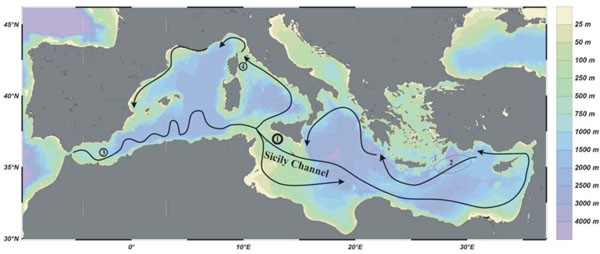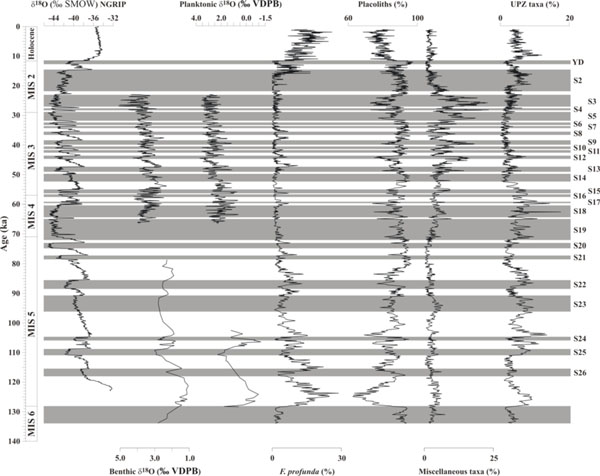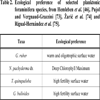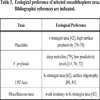- Home
- About Journals
-
Information for Authors/ReviewersEditorial Policies
Publication Fee
Publication Cycle - Process Flowchart
Online Manuscript Submission and Tracking System
Publishing Ethics and Rectitude
Authorship
Author Benefits
Reviewer Guidelines
Guest Editor Guidelines
Peer Review Workflow
Quick Track Option
Copyediting Services
Bentham Open Membership
Bentham Open Advisory Board
Archiving Policies
Fabricating and Stating False Information
Post Publication Discussions and Corrections
Editorial Management
Advertise With Us
Funding Agencies
Rate List
Kudos
General FAQs
Special Fee Waivers and Discounts
- Contact
- Help
- About Us
- Search

The Open Paleontology Journal
(Discontinued)
ISSN: 1874-4257 ― Volume 5, 2014
Ten Years of Paleoceanographic Studies at ODP Site 963 (Central Mediterranean Sea)
Enrico Di Stefano, Alessandro Incarbona*, Rodolfo Sprovieri, Serena Ferraro
Abstract
The geographical location, the shape and the circulation pattern makes the Mediterranean Sea an ideal laboratory to study the interplay between different climatic systems, abrupt climate changes and the response of marine ecosystems. The Ocean Drilling Program Site 963 was drilled in the Northwestern part of the Sicily Channel, the sill that divides the western from the eastern Mediterranean Sea. Numerous papers have been published on Site 963 sediments in the last decade, investigating Mediterranean paleoceanographic themes. Here we offer a synthetic framework of these investigations carried out by sub-centennial resolution. We present the whole sequence of suborbital climatic oscillations over the last 130 kyr, that is since the last interglacial period, and we claim that teleconnection with Greenland and North Atlantic regions is the most likely phenomenon to explain our results. Furthermore we show the high sensitivity of marine planktonic (planktonic foraminifera and coccolithophores) ecosystems to Stadial/Interstadial fluctuations. We conclude that a three-steps scenario may describe productivity variations during each high-frequency oscillation, from Interstadial 24 to the last deglaciation (from 110 to 15 kiloyears ago): surface oligotrophy and a deep nutricline in the lower part of Interstadials; increased productivity, through a deep chlorophyll maximum and winter/spring coccolithophore blooms, during the upper part of Interstadials; a shallow nutricline during Stadials and possibly reduced productivity levels with respect to the upper Interstadial phase. Results from Site 963 investigations provide key information for very high-resolution paleoceanographic research in the Mediterranean Sea.
Article Information
Identifiers and Pagination:
Year: 2014Volume: 5
First Page: 10
Last Page: 19
Publisher Id: TOPALOJ-5-10
DOI: 10.2174/1874425701405010010
Article History:
Received Date: 11/12/2013Revision Received Date: 10/2/2014
Acceptance Date: 21/2/2014
Electronic publication date: 7/3/2014
Collection year: 2014
open-access license: This is an open access article licensed under the terms of the Creative Commons Attribution Non-Commercial License (http://creativecommons.org/licenses/by-nc/3.0/), which permits unrestricted, non-commercial use, distribution and reproduction in any medium, provided the work is properly cited.
* Address correspondence to this author at the Università degli Studi di Palermo, Dipartimento di Scienze della Terra e del Mare, Via Archirafi 22, 90134 Palermo, Italy; Tel: +3909123864648; E-mail alessandro.incarbona@unipa.it
| Open Peer Review Details | |||
|---|---|---|---|
| Manuscript submitted on 11-12-2013 |
Original Manuscript | Ten Years of Paleoceanographic Studies at ODP Site 963 (Central Mediterranean Sea) | |
1. INTRODUCTION
Since the recovery of sapropel layers in the eastern Mediterranean sediments [1], the paleoceanographic research in the region was especially devoted to the comprehension of processes that led to bottom anoxia. Currently, nutricline dynamics and paleoproductivity levels [2-4] and the impact of increased monsoon activity and runoff from North African rivers that may have caused the failure of deep water formation [5, 6] are among the most important topics to understand the origin of sapropels.
In spite of the geographical location, the shape of the basin and the circulation pattern, the Mediterranean basin is an ideal site to investigate the interplay between different climatic systems, abrupt climate changes and the response of marine ecosystems. Cacho et al. [7-10] published a series of papers based on the Alboran Sea sedimentary archive (core MD95-2043) that disclosed the sensitivity of the Mediterranean Sea to the last glacial suborbital climatic oscillations: the occurrence of the whole sequence of Stadials (cold water phases) and Interstadials (warm water phases) over the last 50 kiloyears (kyr), synchronized to the same events in the Northern Hemisphere (Greenland ice cores and North Atlantic sedimentary cores); a circulation pattern strengthened during Stadials (and Heinrich events) and weakened during Interstadials, that is opposite to the Atlantic Meridional Overturning Circulation fashion; productivity levels decreased during Stadials and Heinrich events and vice versa increased during warm water phases. The work of these authors opened a new line of paleoceanographic research in the very high-resolution sedimentary record of the western and central Mediterranean Sea.
The Ocean Drilling Program (ODP) Site 963 was drilled in the Northwestern part of the Sicily Channel, the sill that divides the western and the eastern Mediterranean subbasin. This area is nowadays very sensitive to modifications in the Mediterranean thermohaline circulation [11, 12] and, for many reasons, suitable for paleoceanographic research: the very high-sedimentation rate of Site 963, specifically between 18.0 and 50.0 cm/kyr over the last 130 kyr [13-16]; the flow of Levantine Intermediate Water (LIW) at the sea floor, a key water mass for understanding Mediterranean oceanographic dynamics; the middle-latitude location, suitable to provide information on the interaction among different climatic systems.
Since the study of Sprovieri et al. [13], dealing with calcareous plankton ecobiostratigraphy during the last 18 kyr, numerous papers have been published on Site 963 sediments, investigating Mediterranean paleoceanographic themes. They are listed in Table 1. Here we offer a synthetic framework for the detectment and interpretation of suborbital climatic oscillations, focussing on the last 130 kyr, that is since the last interglacial period, and examine the response of marine ecosystems (planktonic foraminifera and coccolithophores).
2. THE MEDITERRANEAN SEA: OCEANOGRAPHY AND CLIMATOLOGY
2.1. Oceanographic Circulation
The Mediterranean is a semi-enclosed sea, with a thermohaline circulation that reproduces global ocean processes. Surface waters, called Modified Atlantic Water (MAW), enter from the Atlantic Ocean (Fig. 1 ) and occupy the first 100-200 m of the water column. MAW flows and, at the entrance of the Sicily Strait, separates into two branches [17]. Into the Sicily Channel, MAW is again split into two streams, southeast of Pantelleria [18, 19]: the Atlantic Tunisian Current that reaches the African coast and flows eastwards as a coastal current [19, 20]; the northern branch, called the Atlantic Ionian Stream (AIS), that contributes to the MAW transport into the eastern Mediterranean off the southern coast of Sicily. Three semipermanent mesoscale summer features are associated with AIS meanders, mainly in response to topographical effects, the Adventure Bank Vortex (ABV), the Maltese Channel Crest and the Ionian Shelfbreak Vortex [19, 21].
) and occupy the first 100-200 m of the water column. MAW flows and, at the entrance of the Sicily Strait, separates into two branches [17]. Into the Sicily Channel, MAW is again split into two streams, southeast of Pantelleria [18, 19]: the Atlantic Tunisian Current that reaches the African coast and flows eastwards as a coastal current [19, 20]; the northern branch, called the Atlantic Ionian Stream (AIS), that contributes to the MAW transport into the eastern Mediterranean off the southern coast of Sicily. Three semipermanent mesoscale summer features are associated with AIS meanders, mainly in response to topographical effects, the Adventure Bank Vortex (ABV), the Maltese Channel Crest and the Ionian Shelfbreak Vortex [19, 21].
 |
Fig. (1) Bathymetric map of the Mediterranean Sea, surface water circulation in winter [17, 23] and Mediterranean cores’ location. Black circles and ellipses indicate: 1: ODP Site 963 cores; 2: LIW formation area [22, 23]; 3: MD95-2043 and ODP Site 977 cores [7, 51]; 4: MD01-2434 and MD01-2472 cores [60]. |
Levantine Intermediate Water (LIW) forms in the eastern basin in winter due to surface cooling on salt-enriched water masses (Fig. 1 ) [22, 23]. LIW occupies a depth between 150-200 and 600 m, is ubiquitous throughout the eastern basin and enters the Sicily Channel through the sills south of Malta [21].
) [22, 23]. LIW occupies a depth between 150-200 and 600 m, is ubiquitous throughout the eastern basin and enters the Sicily Channel through the sills south of Malta [21].
Dense water forms in the northern part of the basin, in the Gulf of Lions (Western Mediterranean Deep Water - WMDW) and in the Adriatic and Aegean Sea (Eastern Mediterranean Deep Water - EMDW). The dense water formation process starts with the blowing of very cold and dry air masses (Mistral, Bora and Etesian) which causes deep convection throughout the water column. Surface water mixes with LIW and fill the sea bottom. In recent epochs, EMDW and WMDW have never been in touch, because of the topographical barrier constituted by the Sicily Channel.
2.2. Nutrient Dynamics
The trophic resources of the Mediterranean Sea are among the poorest in the world’s oceans. The anti-estuarine circulation pattern contributes to its maintenance, since, at the Strait of Gibraltar, surface waters coming from the Atlantic Ocean are nutrient depleted, with respect to outflowing waters, mainly constituted by LIW [24, 25]. A significant West-East trophic gradient, with a nutrient depletion (especially phosphorus) and a reduction in primary productivity in the eastern basin for over 3 times, has also been reported [26, 27].
Changes in primary production and dynamics of the water column are seasonally controlled. The winter convection, and less frequent frontal zones or upwelling areas, bring nutrients into the photic zone (mesotrophic regime). An oligotrophic regime, characterized by a much lower level of production, occurs in summer, when a stable stratification, due to the deepening of the summer thermocline down to about 90 m, takes place [28, 29]. The Sicily Channel falls within the ‘non-blooming’ area, characterized by low biomass during late spring-summer and higher biomass during late fall-winter [29].
2.3. Atmospheric Pattern
Most of the Mediterranean region is indirectly under the influence of North Atlantic sea surface temperature (SST), one of the most important factors that drives the atmospheric circulation pattern. Rainy westerlies provide moisture and lower the temperature in winter, whereas the penetration of the Azorean high-pressure cell in summer causes a general drought. Different modes of atmospheric variability in the North Atlantic/Europe region (e.g. the North Atlantic Oscillation and the East Atlantic pattern) may impact on dense water formation sites in the Mediterranean Sea [30].
The easternmost part of the Mediterranean basin is influenced by the seasonal shift in the position of the Intertropical Convergence Zone (ITCZ). The ITCZ is coupled to the Indian Monsoon and the zonal Tropical circulation [31], highlighting a complex interplay between high- and low-latitude components of the climate system.
3. MATERIAL
Hole 963A (longitude 37°01.938’ N, latitude 13°10.896’ E; 470.5 metres below sea level) and Hole 963D (longitude 37°02.148′N, latitude 13°10.686′E; 469.1 metres below sea level) were recovered in the Sicily Strait between the Adventure Bank and the Gela Basin, within the ABV area (Fig. 1 ). The bulk sediment composition is enriched in the terrigenous detrital matter [32] and several sapropelitic layers occur in the lowermost part of the sedimentary record [33, 34]. Six tephra layers, associated to the Pantelleria island volcanic activity, have been identified [35]. The ODP1 tephra, corresponding to the Green Tuff and the Y-6 layer in the scheme of Keller et al. [36] falls within the sedimentary sequence here selected.
). The bulk sediment composition is enriched in the terrigenous detrital matter [32] and several sapropelitic layers occur in the lowermost part of the sedimentary record [33, 34]. Six tephra layers, associated to the Pantelleria island volcanic activity, have been identified [35]. The ODP1 tephra, corresponding to the Green Tuff and the Y-6 layer in the scheme of Keller et al. [36] falls within the sedimentary sequence here selected.
4. METHODS
4.1. Coccolithophores
Calcareous nannofossil analysis was carried out on 1121 samples [13-16, 37-39] by observation with a polarized microscope at about 1250 X magnification. Rippled smear slides were prepared following the standard procedure [40]. A total of 300-500 specimens within the entire assemblage were analysed. Quantitative data were collected on more than 20 taxonomic units, generally following the taxonomic concepts on living coccolithophores of Young et al. [41]. Gephyrocapsids were identified to a species level when they are at least 3 µm long, whereas smaller specimens were grouped into small Gephyrocapsa. Small placolihs include Reticulofenestra spp. and very small specimens of Emiliania huxleyi with slight diagenetic problems (dissolved T-shaped elements). Florisphaera profunda includes rare specimens of Gladiolithus flabellatus.
Taxa were grouped into ‘placoliths’, ‘miscellaneous group’, ‘upper photic zone (UPZ) group’ and ‘lower photic zone. (LPZ) group on the basis of distinctive morphologies and biogeographies [42, 43]. Placoliths include E. huxleyi, small placoliths, small Gephyrocapsa, Gephyrocapsa muellerae and Gephyrocapsa oceanica. Miscellaneous group includes Helicosphaera spp., Coccolithus pelagicus, Syracosphaera histrica, Oolithotus fragilis, Pontosphaera spp., Calcidiscus leptoporus, Pleurochrysis spp., Braarudosphaera spp. and specimens of all the other species. UPZ group includes Syracosphaera pulchra, Umbellosphaera spp., Discosphaera tubifera, Rhabdosphaera spp., Umbilicosphaera spp., Calciosolenia spp., holodiscolithus, Ceratolithus spp. and the dinoflagellate Thoracosphaera heimii [44]. Finally, given the rarity of Gladiolithus flabellatus and given that Algirosphaera robusta was not found in any sample, F. profunda is the main species of the ‘lower photic zone’ (LPZ) group.
The ecological preference of groups is shown in Table 2.
4.2. Planktonic Foraminifera
A total of 2188 samples [13, 14, 16, 38, 39] were dried and washed on a 63µm sieve for planktonic foraminifera analysis. The relative abundance of each species was obtained from splits of about 300 specimens, in the residue greater than 125 µm. Taxonomic concepts follow Bolli et al. [45] and Hemleben et al. [46]. Globigerinoides quadrilobatus includes Globigerinoides trilobus and Globigerinoides sacculifer. Globigerina bulloides includes Globigerina falconensis. The paleoclimate curve is the algebraic sum of warm-water species percentages (G. ruber, Globigerina siphonifera, Globigerinoides quadrilobatus, Globoturborotalita rubescens,Globoturborotalita tenella) expressed as positive values and cold-water species percentages (Neogloboquadrina pachyderma, G. bulloides, Turborotalita quinqueloba, Globorotalia scitula and Globigerinita glutinata) expressed as negative values, following previous studies [14, 47]. The ecological preference of selected taxa is shown in Table 3.
4.3. Oxygen Isotopes
During the last glacial period, the oxygen isotope analysis was carried out on about 5/10 specimens of the planktonic foraminifera species Neogloboquadrina pachyderma (right coiling – r.c.), for a total of 522 samples, and the benthic foraminifera species Cibicidoides pachyderma, for a total of 517 samples [16]. Samples were measured in an automated continuous flow carbonate preparation GasBenchII device [48] and a ThermoElectron Delta Plus XP mass spectrometer at the IAMC-CNR (Naples) isotope geochemistry laboratory. Acidification of samples was performed at 50°C. An internal standard (Carrara Marble with δ18O = -2.43‰ versus VPDB) was run every 6 samples and the NBS19 international standard was measured every 30 samples.
Oxygen isotope data were also obtained on 1 to 2 specimens of the benthic foraminifera species C. pachyderma (65 samples) for the whole MIS 5 and from about 10 specimens of G. ruber (35 samples) [14]. Measurements were made at the Woods Hole Oceanographic Institution on a Finnegan MAT353 stable isotope mass spectrometer following standard procedures [49].
5. CHRONOLOGICAL FRAMEWORK
The chronological framework here presented follows Sprovieri et al. [14] for the MIS 5 interval (130-70 kiloyears ago – ka), Sprovieri et al. [16] for the last glacial (70-20 ka) and Incarbona et al. [15] for the Holocene (11.6-0 ka). The age model is complemented by the correlation between the planktonic foraminifera paleoclimatic curve from data of Sprovieri et al. [13] and the Greenland ice core δ18O curve [50] along the last deglaciation, thus including the Bolling-Allerød and the Younger Dryas base.
Specifically, a peak to peak correlation has been carried out between the planktonic foraminifera paleoclimatic curve and δ18O data of NGRIP ice cores for the 122-70 ka time slice and the MIS 6/MIS 5 boundary age has been imported by Martrat et al. [51]. A peak to peak correlation has been carried out between high abundance values of G. ruber (together with light values in the benthic and planktonic δ18O data) and interstadials in the Greenland Ice Core Chronology of Andersen et al. [52] and Svensson et al. [53, 54], and two calibrated radiocarbon ages for the last glacial period [16]. Finally, the Holocene chronological framework has been built on the basis of linear interpolation between six dated (calibrated radiocarbon ages) horizons [15].
Data from Holes 963A and 963D were joined in order to obtain a composite section. The first adopted criterion was based on the physical property of the section, following the indication of Sakamoto et al. [55], and in particular the distinctive peak of about 10 instrument units of magnetic susceptibility identified at 6.92 mbsf in Hole 963A and at 7.35 in Hole 963D [56]. The latter level benefits from a radiocarbon dating, which calibrated age is 19.73 kyr BP. The calibrated age for the depth of 6.92 mbsf at Hole 963A, deduced by linear interpolation between the two dated horizons of core 2H, is 19.52 kyr BP, which is within the error associated to the method.
The peak to peak synchronization between Greenland ice core and Mediterranean suborbital climatic fluctuations is justified by teleconnection phenomena [7, 8, 57]. Cacho et al. [7] developed two alternative age models for the last 50 kyr in the Alboran Sea, respectively based on calibrated radiocarbon datings and synchronization of alkenone-based sea surface temperatures with δ18O data from Greenland ice cores, which are remarkably in agreement. The ODP 963 site supports the validity of the teleconnection assumption between Mediterranean and Greenland climatic fluctuations, through the comparison of the age of ODP1 tephra, respectively estimated at 45.0 ± 0.9 ka by the constrain of Dansgaard-Oeschger oscillations [16, 39] and high resolution 40Ar/39Ar dating at 45.7 ± 1.0 [58].
The adopted tie-points are listed in Table 4.

List of the adopted tie-point used to assess the age model. From the left, the depth in mbsf; the age in ka; the indication of the tie-points’ sequence. IS 2-IS 18 refers to the sequence of Interstadials, the tie-points used for the last glacial period. S 20-S 26 refers to the sequence of Stadials, the tie-points used for MIS 5.
6. DISCUSSION
6.1. Suborbital Climatic Oscillation
The whole sequence of Stadial (S) and Interstadial (IS) oscillations since the last interglacial (~ 130 ka) is shown in Figs. (2 and 3
and 3 ), which have been built by joining data from Site 963 Hole D and Hole A [13-16, 37-39]. The climatic fluctuations are identified by variations in the planktonic foraminifera and oxygen isotopic curves (Fig. 2
), which have been built by joining data from Site 963 Hole D and Hole A [13-16, 37-39]. The climatic fluctuations are identified by variations in the planktonic foraminifera and oxygen isotopic curves (Fig. 2 ). Interstadials are marked by abundance peaks of the warm water species G. ruber (Fig. 2
). Interstadials are marked by abundance peaks of the warm water species G. ruber (Fig. 2 ). Cold water species G. bulloides, N. pachyderma dx and T. quinqueloba replace one each other during Stadials, even if indeed T. quinqueloba abundance peaks mark most of the Stadials (Fig. 2
). Cold water species G. bulloides, N. pachyderma dx and T. quinqueloba replace one each other during Stadials, even if indeed T. quinqueloba abundance peaks mark most of the Stadials (Fig. 2 ).
).
 |
Fig. (2) Downcore variations of geochemical data and planktonic foraminifera species at ODP Site 963, plotted versus calibrated age (kyr) and showing the marine isotopic stratigraphic framework. From the left, oxygen isotopic record of Greenland ice cores [50]; benthic and planktonic oxygen isotopic records at ODP Site 963 [14, 16]; distribution patterns of G. ruber, G. bulloides, T. quinqueloba and N. pachyderma dx at ODP Site 963, expressed as percentage values [13, 14, 16, 39]; downcore variations of the planktonic foraminifera paleoclimatic curve. Light grey bands mark Stadials, white bands mark Interstadials. S26-S2 show the sequence of Stadials across the sequence. YD: Younger Dryas. |
 |
Fig. (3) Downcore variations of geochemical data and coccolithophore taxa and groups at ODP Site 963, plotted versus calibrated age (kyr) and showing the marine isotopic stratigraphic framework. From the left, oxygen isotopic record of Greenland ice cores [50]; benthic and planktonic oxygen isotopic records at ODP Site 963 [14, 16]; distribution patterns of F. profunda, placoliths, miscellaneous and UPZ taxa at ODP Site 963, expressed as percentage values [13-16, 39]. Light grey bands mark Stadials, white bands mark Interstadials. S26-S2 show the sequence of Stadials across the sequence. YD: Younger Dryas. |
Less regular is the situation looking at coccolithophore assemblages. Placoliths abundance peaks fall in coincidence of many Stadials of MIS 5, mainly controlled by increases in percentage values of G. muellerae [14, 38] and of the Younger Dryas (Fig. 3 ). During the last glacial period, the interval between MIS 4 and MIS 2, many Stadials are characterized by increased relative abundances of Miscellaneous taxa (Fig. 3
). During the last glacial period, the interval between MIS 4 and MIS 2, many Stadials are characterized by increased relative abundances of Miscellaneous taxa (Fig. 3 ), such as Helicosphaera carteri and S. histrica [39]. Florisphaera profunda peaks can be seen in most of the Interstadials throughout the sedimentary sequence (Fig. 3
), such as Helicosphaera carteri and S. histrica [39]. Florisphaera profunda peaks can be seen in most of the Interstadials throughout the sedimentary sequence (Fig. 3 ) and remarkably abundance fluctuations of this species gather the subtle oscillations occurred during the Holocene [15]. Increased abundance of UPZ taxa are recorded in both Stadials and Interstadials, but a significant occurrence is recorded at the beginning of both interglacials, MIS 5 and Holocene (Fig. 3
) and remarkably abundance fluctuations of this species gather the subtle oscillations occurred during the Holocene [15]. Increased abundance of UPZ taxa are recorded in both Stadials and Interstadials, but a significant occurrence is recorded at the beginning of both interglacials, MIS 5 and Holocene (Fig. 3 ).
).
The whole sequence of suborbital climatic fluctuations has already been found in the western Mediterranean (Alboran) Sea by alkenone-derived SSTs and is even extended down to the past 250 kyr [51]. The fact that a wide sector of the Mediterranean Sea shows the same response to suborbital climatic fluctuations, in terms of SST, provides a robust support to the possible teleconnection with the Greenland and North Atlantic regions. In other words, there is not a hydrological-mediated response (e.g. local upwelling and mesoscale cyclonic or anticyclonic gyres), but a unique regional behaviour, likely due to atmospheric phenomena, for instance the Polar Vortex expansion during Stadials [8, 59].
There is not any direct evidence of the occurrence of suborbital climatic fluctuations in micropaleontological and geochemical studies carried out in the eastern Mediterranean Sea. However, physico-chemical properties (e.g. salinity and/or temperature), speed, ventilation and the vertical location of the LIW, the intermediate water mass formed in the Rhodes gyre area, seem to change during Stadial/Interstadial oscillations over the past 130 ka, both in the Sicily Channel and the Corsica Trough [14, 16, 60]. Further investigation is needed to understand processes that acted in the eastern Mediterranean basin, among others the role of the African monsoon variability in driving and/or preconditioning LIW formation processes.
6.2. Paleoproductivity Variations
Throughout the ODP 963 site sedimentary sequence there is a link between Stadial/Interstadial fluctuations and changes in productivity levels and the vertical structure of the water column. Interstadials are characterized by oligotrophic surface waters (peaks of G. ruber and at least partially of the coccolithophore UPZ taxa) and a deep nutricline (peaks of F. profunda). Increased surface productivity can be inferred for most stadials on the basis of the enhanced percentage abundance of G. bulloides, N. pachyderma dx, T. quinqueloba and placoliths (Figs. 2 and 3
and 3 ). Indeed, the in depth evaluation of the distribution pattern of these taxa during the suborbital fluctuations of the last glacial period highlights a more complicated situation during each Stadial/Interstadial cycle [39]: surface oligotrophy and a deep nutricline confined to the lower part of interstadials; increased productivity after blooms, during the upper part of Interstadials; a shallow nutricline during Stadials, possibly characterized by disturbance in surface productivity, that is reduced productivity levels with respect to the upper Interstadial phase.
). Indeed, the in depth evaluation of the distribution pattern of these taxa during the suborbital fluctuations of the last glacial period highlights a more complicated situation during each Stadial/Interstadial cycle [39]: surface oligotrophy and a deep nutricline confined to the lower part of interstadials; increased productivity after blooms, during the upper part of Interstadials; a shallow nutricline during Stadials, possibly characterized by disturbance in surface productivity, that is reduced productivity levels with respect to the upper Interstadial phase.
Looking back at the MIS 5 interval, there is little doubt that the three-scenarios interpretation can also be adopted, at least since Is 24 (between S 25 and S 24), where N. pachyderma dx peaks cover the upper part of Interstadials (Fig. 2 ) and Stadials are characterized by marked abundance fluctuations of placoliths (Fig. 3
) and Stadials are characterized by marked abundance fluctuations of placoliths (Fig. 3 ). Thus, the real Stadial/high surface productivity and Interstadial/low surface productivity coupling seems to be restricted to the lowermost part of MIS 5, up to S 25 that marks the decline of arboreal pollen in southern Europe [61, 62], and the last deglaciation (Bolling-Allerød and Younger Dryas).
). Thus, the real Stadial/high surface productivity and Interstadial/low surface productivity coupling seems to be restricted to the lowermost part of MIS 5, up to S 25 that marks the decline of arboreal pollen in southern Europe [61, 62], and the last deglaciation (Bolling-Allerød and Younger Dryas).
The same productivity style across Stadial/Interstadial oscillations observed in the Sicily Channel and the Alboran Sea suggests the influence of sea level fluctuations and of the inflow through the Gibraltar strait of fresher water of polar origin on marine planktonic ecosystems [39]. In fact, the lower global sea level during the last glacial may have led to a strong decrease in the Atlantic/Mediterranean exchange and a subsequent density gradient increase between surface and subsurface water [63, 64], significantly suppressing vertical mixing. The same effect may be ascribed to the inflow of fresher water of polar origin during Stadials that is documented by light oxygen isotopic values in planktonic foraminifera shells in coincidence of most of North Atlantic Heinrich events [16, 65]. Both these processes are suitable to explain the disturb in surface productivity in Stadials of the upper part of MIS 5 in the Sicily Channel record, given that the S 25 event marks the first significant sea level drop [66, 67] and the first significant occurrence of ice rafted detritus in the North Atlantic record [68] since the MIS 6/MIS 5 transition.
One of the main avenues of research in paleoceanography is the use of microfossil assemblages for quantitative reconstructions by transfer functions [69]. Following the approach of Beaufort et al. [70], the study of coccolithophore assemblages from the Sicily Channel surface sediments led to the identification of a close relationship between percentage values of F. profunda and productivity levels deduced by satellite imagery [15, 71]. The output transfer function allows F. profunda percentage values to be changed into net primary production data (mgC x m-2 x yr-1) through a natural logarithm formula. Interestingly, the same kind of formula has later proven to be suitable to determine net primary production data by F. profunda percentage values in the eastern Mediterranean Sea [72].
7. CONCLUSION
Sub-centennial-scale micropaleontological and geochemical records have been presented from the Sicily Channel ODP Site 963. They show the whole sequence of Stadial and Interstadial oscillations since the last interglacial (~ 130 ka), from S 26 to S2 and also including Bolling-Allerød and Younger Dryas. The fact that the same sequence has been found by alkenone-based SST in the Alboran Sea strongly support the occurrence of teleconnection between the western-central Mediterranean Sea and the Greenland/North Atlantic region.
The ODP 963 record shows a permanent link between Stadial/Interstadial fluctuations and changes in productivity levels and the vertical structure of the water column. The three-scenarios interpretation adopted for each Stadial/Interstadial oscillation during the last glacial period [39] may also be extended down to Is 24 (~ 110 ka). Disturbance in productivity produced by low global sea level and inflow of fresher water of polar origin is compatible with this extension given that the S 25 event marks the first significant sea level drop [66, 67] and the first significant occurrence of ice rafted detritus in the North Atlantic record [68] since the MIS 6/MIS 5 transition.
In conclusion, investigations carried out on the Site 963 record provide a valuable key for the comprehension of paleoceanographic variations triggered by high-frequency climatic fluctuations. The investigations also provide a valuable dataset to be compared by studies from different Mediterranean areas.
CONFLICT OF INTEREST
The authors confirm that this article content has no conflicts of interest.
ACKNOWLEDGEMENTS
We are grateful to three anonymous reviewers for their valuable comments and suggestions. The research has benefit from funding from MIUR ex 60% grants to E. Di Stefano.



